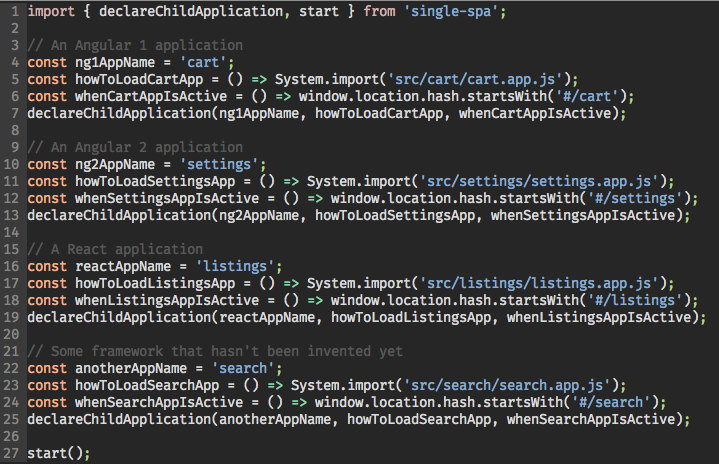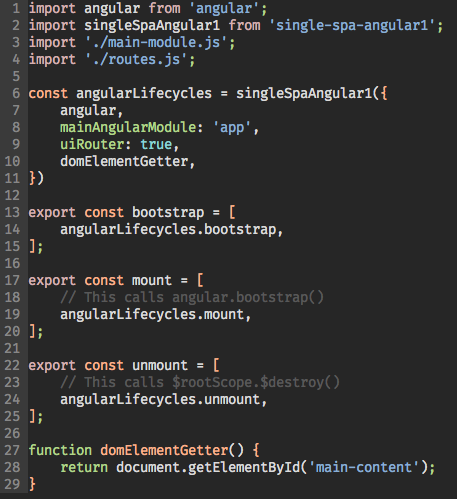If you’re hoping to migrate your Angular 1 application to Angular 2, you’re going to hear about the Angular Upgrade Adapter, which let’s you run ng1 and ng2 apps side by side.
It’s not that Angular Upgrade Adapter is bad or poorly written or doesn’t work. And it’s not the Typescript or the Angular 2 or the SystemJS.
But here are two reasons that will make you think twice about using Angular Upgrade Adapter:
1. You’ll still have to rewrite everything

This comic strip is a real story, and I am the Dilbert. One time at Amazon I made a joke to my product manager. It was about rewriting code. He didn’t laugh. Then I joked about how he didn’t think it was funny. Still nothing. Then I walked away.
2. You’ll probably have to do this again, anyways
I think I've had milk last longer than some JavaScript frameworks.
— I Am Devloper (@iamdevloper) December 4, 2014
Developers are just machines that consume Twitter and produce frameworks. And, really, I wouldn’t have it any other way. Trying out a new framework is just too fun to give up. And when I’m not the one pushing for us to try out the new shiny, somebody else is. Even if we have that big meeting where we talk for an hour and a half and everyone agrees that Angular 2 is the “framework we decided on”, it won’t last.
So is this just how new frameworks are?
For a long time I thought the solution to the “framework problem” was staying on top of everything. If I migrate early to beta versions and release candidates, somehow that makes my inability to switch frameworks okay. Another thing I thought was that if I could just find the right framework that we’d be happy. Or that somehow we could cure ourselves of the desire to switch frameworks.
Turns out that’s just not true. And once I accepted that, I realized it’s totally okay!
Let’s get meta.
I think it’s time for the Javascript community to get meta with frameworks. Instead of finding the right framework and hoping that it works out, what if we were capable of simultaneously using any number of frameworks?
What if we had a bring-your-own-framework mentality where multiple apps cooperate within one SPA? A framework for using frameworks.
A Javascript metaframework.
Where I work this is what we’ve been trying to figure out. What would something like this even mean? Could we start each project as a green field instead of locked-in to our previous technology decisions? How do we pull it off?
A different approach
What we’ve come up with is a project called single-spa and so far we love it. It’s an alternative to upgrade guides and migration tools. An early entry to the nascent world of “Javascript metaframeworks.”
Instead of migrating your large Angular 1 application to Angular 2, single-spa has you split it up into several small applications that coexist in the same SPA. Once split up, you can tackle each one of the applications individually. When Angular 2 makes sense, migrate one of the apps to be Angular 2. If React makes sense, rewrite one of them in React.
Or if you don’t want to rewrite anything at all, just let your application remain while still giving yourself the option to try something else for new projects.

The benefit is that your approach is framework-agnostic. When you want to try out a new framework, you have a way to do so. Compare this to Angular Upgrade Adapter, which is a one-way door that leads to Angular 2. What do you do when you want to try out React or something else?
What single-spa is doing is managing your applications for you. You can think of it like a framework agnostic router on top of all other applications. It manages which applications are active and which ones are dormant.
How to try it out
Single-spa works with es5, es6+, typescript, webpack, systemjs, gulp, grunt, bower, or really any build system you can think of. You can npm install it, jspm install it, or even just use a script tag if you prefer. It works in Chrome, Firefox, Safari, Edge, and (at least) IE11.
To give it a shot, you’ll have to migrate your SPA to become a single-spa child application. After you do so, the entry file to your application will look something like this:

Once you’ve added a file like this to your app, you’re ready! You can keep your existing ui-router configuration and your ng1 controllers, services, and directives.
The docs for single-spa are located here, let us know what you think!
Originally posted at https://medium.com/@joeldenning/a-case-against-angular-update-adapter-d4e121282a11
